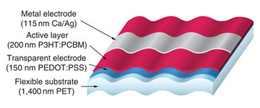Research Abstract
柔軟性の高い極薄軽量有機太陽電池
Ultrathin and lightweight organic solar cells with high flexibility
2012年4月3日 Nature Communications 3 : 770 doi: 10.1038/ncomms1772

次世代の照明、ディスプレイ、太陽電池において応用上求められている性能は、大面積性、軽量、機械的柔軟性である。これら次世代の光学電子デバイスは、例えば表面に順応してさまざまに形状変形できる電子皮膚や電子布地などセンサーと融合した形で応用が模索されている。今回我々は、厚さ2 µm以下のプラスチックフィルム基板上に軽量薄型の有機太陽電池の作製に成功した。厚さ2 µm以下のフィルム上であるにもかかわらず、この薄型有機太陽電池の電力変換効率は、ガラス基板上に作製した有機太陽電池と同じであった。さらに、この有機太陽電池は、極めて高い機械的柔軟性を持ち、極端な折り曲げひずみを加えても耐えることができた。特に、単位重量当たりの発電量は世界最大であり、あらゆる太陽電池と比べても、10倍以上薄く、軽く、柔軟である。我々は、この太陽電池において単なる折り曲げ特性を示すのみならず、高い機械的柔軟性を生かして、伸縮自在な三次元波型形状(折り目のランダムネットワーク)をゴム基板上に形成することに成功した。一連の作製プロセスは標準的なものであるため、太陽電池のみならず発光ダイオード、コンデンサー、トランジスターにおいても同程度の重量と柔軟性を生み出すことが可能で、将来的には極薄有機電子機器を十分に実現することができるであろう。
- Department of Soft Matter Physics, Johannes Kepler University(オーストリア)
- 東京大学大学院 工学系研究科 電気系工学専攻
- 科学技術振興機構(JST)ERATO
- Department of Physical Chemistry, Linz Institute for Organic Solar Cells (LIOS), Johannes Kepler University Linz(オーストリア)
Application-specific requirements for future lighting, displays and photovoltaics will include large-area, low-weight and mechanical resilience for dual-purpose uses such as electronic skin, textiles and surface conforming foils. Here we demonstrate polymer-based photovoltaic devices on plastic foil substrates less than 2 μm thick, with equal power conversion efficiency to their glass-based counterparts. They can reversibly withstand extreme mechanical deformation and have unprecedented solar cell-specific weight. Instead of a single bend, we form a random network of folds within the device area. The processing methods are standard, so the same weight and flexibility should be achievable in light emitting diodes, capacitors and transistors to fully realize ultrathin organic electronics. These ultrathin organic solar cells are over ten times thinner, lighter and more flexible than any other solar cell of any technology to date.

